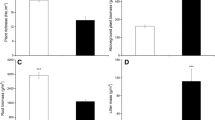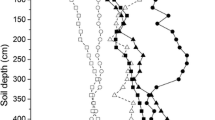Abstract
In order to restore a degraded alkaline grassland, the local government implemented a large restoration project using fences in Changling county, Jilin province, China, in 2000. Grazing was excluded from the protected area, whereas the grazed area was continuously grazed at 8.5 dry sheep equivalent (DSE)/hm2. In the current research, soil and plant samples were taken from grazed and fenced areas to examine changes in vegetation and soil properties in 2005, 2006 and 2008. Results showed that vegetation characteristics and soil properties improved significantly in the fenced area compared with the grazed area. In the protected area the vegetation cover, height and above- and belowground biomass increased significantly. Soil pH, electrical conductivity and bulk density decreased significantly, but soil organic carbon and total nitrogen concentration increased greatly in the protected area. By comparing the vegetation and soil characteristics with pre-degraded grassland, we found that vegetation can recover 6 years after fencing, and soil pH can be restored 8 years after fencing. However, the restoration of soil organic carbon, total nitrogen and total phosphorus concentrations needed 16, 30 and 19 years, respectively. It is recommended that the stocking rate should be reduced to 1/3 of the current carrying capacity, or that a grazing regime of 1-year of grazing followed by a 2-year rest is adopted to sustain the current status of vegetation and soil resources. However, if N fertilizer is applied, the rest period could be shortened, depending on the rate of application.
Similar content being viewed by others
References
Bauer A, Cole C V, Black A L. 1987. Soil property compares on in virgin grasslands between grazed and nongrazed management systems. Soil Science Society America Journal, 51(1): 176–182.
Daily G C. 1995. Restoring value to the worlds degraded lands. Science, 26(5222): 350–354.
Dakhah M, Gifford G F. 1980. Influence of vegetation, rock cover and trampling on infiltration rates and sediment production. Journal of the American Water Resources Association, 16(6): 979–986.
Dormaar J F, Adams B W, Willms W D. 1994. Effects of grazing and abandoned cultivation on a Stipa-Bouteloua community. Journal Rangeland Management, 47(1): 28–32.
Fleischner T L. 1994. Ecological costs of livestock grazing in western North America. Conservation Biology, 8(3): 629–644.
Gao Q, Yang X S, Yun R, et al. 1996. MAGE, a dynamic model of alkaline grassland ecosystems with variable soil characteristics. Ecological Modelling, 93(1): 19–32.
Gonzales E K, Clements D R. 2010. Plant community biomass shifts in response to mowing and fencing in invaded oak meadows with Non-Native grasses and abundant ungulates. Restoration Ecology, 18(5): 753–761.
Guo Q F. 2007. The diversity-biomass-productivity relationships in grassland management and restoration. Basic and Applied Ecology, 8(3): 199–208.
Hofstede R G M. 1995. The effects of grazing and burning on soil and plant nutrient concentrations in Colombia Páramo grasslands. Plant and Soil, 173(1): 111–132.
Holmgren M, Scheffer M. 2001. El Niño as a window of opportunity for the restoration of degraded arid ecosystems. Ecosystems, 4(2): 151–159.
Institute of Soil Science, Chinese Academy of Sciences. 1978. Physical and Chemical Analysis Methods of Soils. Shanghai: Shanghai Science Technology Press, 87–102.
Jiang S C, He N P, Wu L, et al. 2010. Vegetation restoration of secondary bare saline-alkali patches in the Songnen plain, China. Applied Vegetation Science, 13(1): 47–55.
Klute A. 1986. Methods of Soil Analysis. Part 1-Physical Mineralogical Methods. Madison, WI: American Society of Agronomy, INC, 363–375.
Lavado R S, Sierra J O, Hashimoto P N. 1996. Impact of grazing on soil nutrients in a Pampean grassland. Journal of Range Management, 49(5): 452–457.
Li F R, Zhao W Z, Liu J L, et al. 2009. Degraded vegetation and wind erosion influence soil carbon, nitrogen and phosphorus accumulation in sandy grasslands. Plant and Soil, 317(1–2): 79–92.
Liu Y S, Pan Q M, Liu H D, et al. 2011. Plant responses following grazing removal at different stocking rates in an Inner Mongolia grassland ecosystem. Plant and Soil, 340(1–2): 199–213.
Mainguet M. 1994. Desertification: Natural Background and Human Mismanagement, 2nd eds. Heidelberg: Speringer-Verlag, 306.
Manzano M G, Návar J. 2000. Processes of desertification by goats overgrazing in the Tamaulipan-thrnscrub (matorral) in north-eastern Mexico. Journal of Arid Environments, 44(1): 1–17.
Marriott C A, Hood K, Fisher J M, et al. 2009. Long-term impacts of extensive grazing and abandonment on the species composition, richness, diversity and productivity of agricultural grassland. Agriculture, Ecosystem and Environment, 134(3): 190–200.
Page A L. 1982. Methods of Soil Analysis. Part 2-Chemical and microbiological properties. Madison, WI: American Society of Agronomy, INC, 539–579.
Pei S F, Fu H, Wan C G. 2008. Changes in soil properties and vegetation following exclosure and grazing in degraded Alxa desert steppe of Inner Mongolia, China. Agriculture, Ecosystem and Environment, 124(1): 33–39.
Peterson G, Allen C R, Holling C S. 1998. Ecological resilience, biodiversity, and scale. Ecosystems, 1(1): 6–18.
Pywell R F, Bullock J M, Hopkinsi A, et al. 2002. Restoration of species-rich grassland on arable land: assessing the limiting processes using a multi-site experiment. Journal of Applied Ecology, 39(2): 294–309.
Rubio R W, Bochet E. 1998. Desertification indicators as diagnosis criteria for desertification risk assessment in Europe. Journal of Arid Environment, 39(2): 113–120.
Ruiz-Jaen M C, Aide T M. 2005. Restoration success: how is it being measured? Restoration Ecology, 13(3): 569–577.
Salihi D O, Norton B E. 1987. Survival of perennial grass seedling under intensive grazing in semiarid rangelands. Journal of Applied Ecology, 24(1): 145–151.
Schlesinger W H, Reynolds J F, Cunningham G L, et al. 1990. Biological feedbacks in global desertification. Science, 247(4946): 1043–1048.
Shang Z H, Deng B, Ding L M, et al. 2013. The effects of three years of fencing enclosure on soil seed banks and the relationship with above-ground vegetation of degraded alpine grasslands of the Tibetan plateau. Plant and Soil, 364(1–2): 229–244.
Shi D C, Wang D L. 2005. Effects of various salt-alkaline mixed stresses on Aneurolepidium chinense (Trin.) Kitag. Plant and Soil, 271(1–2): 15–26.
Silver W L, Kueppers L M, Lugo A E, et al. 2004. Carbon sequestration and plant community dynamics following reforestation of tropical pasture. Ecological Applications, 14(4): 1115–1127.
Snyman H A. 2003. Revegetation of bare patches in a semi-arid rangeland of South Africa: an evaluation of various techniques. Journal of Arid Environment, 55(3): 417–432.
Sparks D L, Page A L, Helmke P A, et al. 1996. Methods of Soil Analysis. Part 3-Chemical Methods. Madison, WI: American Society of Agronomy, INC, 1085–1121.
Su Y Z, Zhao H L, Zhang T H, et al. 2004. Soil properties following cultivation and non-grazing of a semi-arid sandy grassland in northern China. Soil and Tillage Research, 75(1): 27–36.
Su Y Z, Li Y L, Cui J Y, et al. 2005. Influences of continuous grazing and livestock exclusion on soil properties in a degraded sandy grassland, Inner Mongolia, northern China. Catena, 59(3): 267–278.
Suding K N, Gross K L, Houseman G R. 2004. Alternative states and positive feedbacks in restoration ecology. Trends in Ecology and Evolution, 19(1): 46–53.
Taylor Jr C A, Garza Jr N E, Brooks T D. 1993. Grazing systems on the Edwards Plateau of Taxas: are they worth the trouble? Rangelands, 15(2): 53–57.
van der Merwe J P A, Kellner K. 1999. Soil disturbance and increase in species diversity during rehabilitation of degraded arid rangelands. Journal of Arid Environment, 41(3): 323–333.
Wang H, Li X, Long H, et al. 2007. Monitoring grassland degradation in Yiminhe Mine of China using TM remotely sensed data. Geoscience and Remote Sensing Symposium, 2007. IGARSS 2007. IEEE International, 3441–3443.
Wang R Z. 2000. Effect of grazing on reproduction in Leymus chinensis population. Chinese Journal Applied Ecology, 11(3): 399–402.
Wang Y, Zhao H L, Zhao X Y. 2013. Effects of land use intensity on the restoration capacity of sandy land vegetation and soil moisture in fenced sandy land in desert area. Contemporary Problems of Ecology, 6(1): 128–136.
Wu G L, Du G Z, Liu Z H, et al. 2009. Effect of fencing and grazing on a Kobresia-dominated meadow in the Qinghai-Tibetan Plateau. Plant and Soil, 319(1–2): 115–126.
Wu G L, Liu Z H, Zhang L, et al. 2010. Long-term fencing improved soil properties and soil organic carbon storage in an alpine swamp meadow of western China. Plant and Soil, 332(1–2): 331–337.
Yayneshet T, Eik L O, Moe S R. 2009. The effects of exclosures in restoring degraded semi-arid vegetation in communal grazing lands in northern Ethiopia. Journal of Arid Environments, 73(4): 542–549.
Zhang W Z. 1994. The relationship between vegetation degeneration and soil salinization in an Aneurolepidium chinense grassland of Songnen plain. Acta Phytoecologica Sinica, 18(1): 50–55.
Zhao W Z, Xiao H L, Liu Z M, et al. 2005. Soil degradation and restoration as affected by land use change in the semiarid Bashang area, northern China. Catena, 59(2): 173–186.
Zhou D W, Li Q, Song Y T, et al. 2011. Salinization-alkalization of Leymus chinensis grassland in Songnen Plain of Northeast China. Chinese Journal Applied Ecology, 22(6): 1423–1430.
Author information
Authors and Affiliations
Corresponding author
Rights and permissions
About this article
Cite this article
Li, Q., Zhou, D., Jin, Y. et al. Effects of fencing on vegetation and soil restoration in a degraded alkaline grassland in northeast China. J. Arid Land 6, 478–487 (2014). https://doi.org/10.1007/s40333-013-0207-6
Received:
Revised:
Accepted:
Published:
Issue Date:
DOI: https://doi.org/10.1007/s40333-013-0207-6




